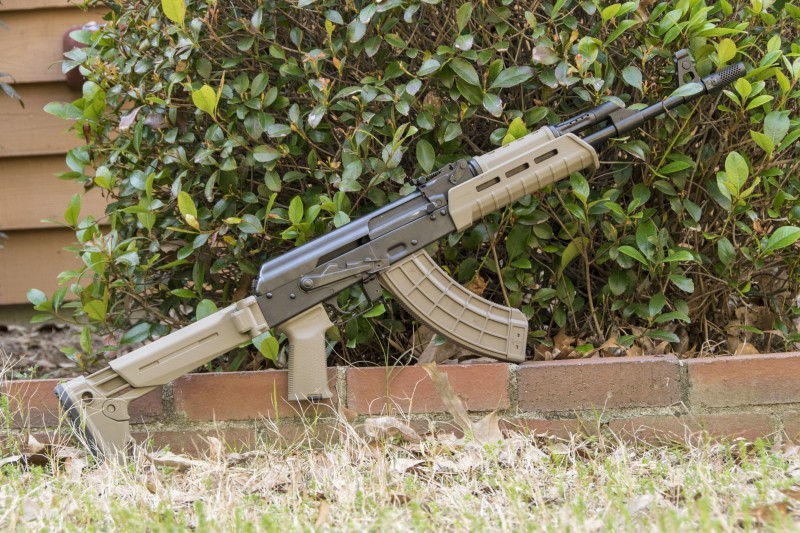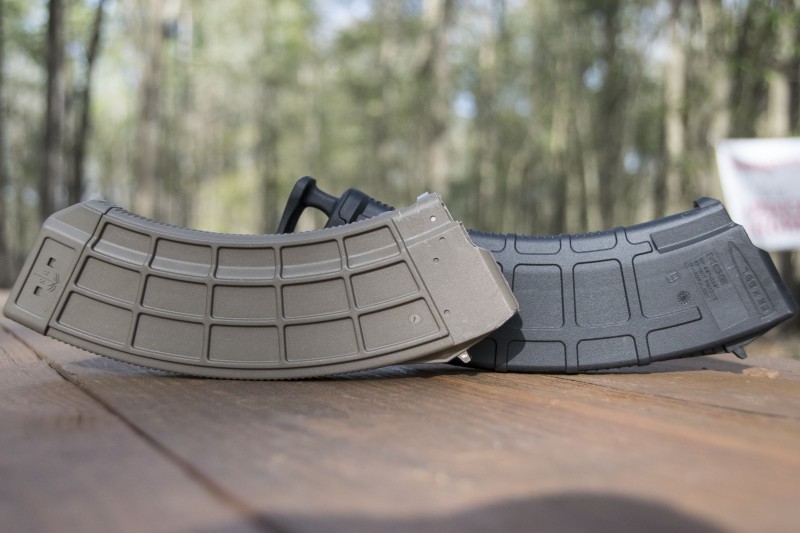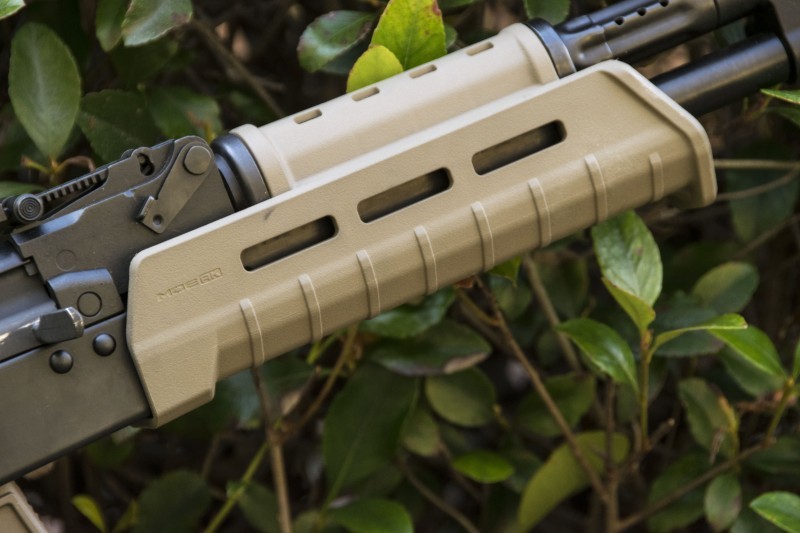The state of the Kalashnikov market in the United States is changing. The days of ultra-cheap parts kits, $200 SKS rifles and $400 AKs are over. The reasons are varied, but the result remains unchanged: retailers looking to satisfy their customer’s hunger for reliable AK carbines need to shift their business model to stay competitive.
To do this isn’t as simple as it seems. While the cost of AK-style rifles, their parts and accessories has increased in the wake of potential gun bans, the shooting public’s perception and expectation has not.
Further complicating things, while the price of AK rifles has steadily increased, the opposite is true of AR-15s. After every shooter with spare cash was busy gobbling up any and everything AR-15, the market became oversaturated. So much so that local gun shops near me can’t move DPMS carbines at dealer cost.
That said, it’s important to understand the mindset of perspective buyers, and how an AK fits their needs.
Thankfully retailers aren’t alone.
Going Domestic
Several manufacturers have begun to produce all-American AK carbines in recent years that intelligently play to the strengths of Russian design and couple them with American innovation and production. As in any market, bigger companies act more conservatively, thus their actions can often be used as a litmus test for risk.
When the largest AK importer in America decides to shift resources from importation to domestic production, the writing is on the wall. That’s right, Century Arms is cutting back the scale of their imported AK carbines in favor of its new C39 and RAS-47 carbines.
What’s interesting about Century’s choice is that the C39 is a milled rifle. While this isn’t uncommon, it’s a peculiar pick for the long-time imported because of the reasons surrounding the original Soviet AK-47 design.
While the first true production run of Mikhail Kalashnikov’s magnum opus used a milled receiver, the design was never intended to be so. The Kalashnikov, like other mass-produced weapons available during the era of its development, was designed around an economy of scale. Arming the massive Soviet Red Army was expensive. This is true whether they’re equipped with swords, spears or automatic rifles.
In order to create an affordable rifle for their military, the original AK utilized a receiver constructed from steel stampings. This wasn’t something revolutionary at the time, the Germans had proved the concept successfully fielding submachine guns and the first true assault rifle utilizing stamped receivers.
Two big reasons a stamped receiver is more cost effective than a milled one: it utilizes far less material in construction and requires less machine time per completed rifle. German engineers ended up enjoying the design so much they built the most prolific submachine gun in history with a stamped receiver — the MP5.
So if this production method is so phenomenal, why didn’t the Russians use it on the AK-47?
The short answer: they couldn’t.
At least not initially. The Soviets lacked the metallurgy knowledge to properly heat treat the receiver flats once bent into shape. This resulted in a rifle failure rate too high for production. Their solution was to utilize the same method of milled receiver construction that saw their Mosin Nagant rifle through two World Wars.
It wasn’t cheap, and it wasn’t light, but it worked. Not long after, once Red Army engineers managed to perfect the heat treatment process, the Soviet military finally fielded the original design under the AKM moniker, or avtomat kalashnikova modernizirovanniy. This new design featured the stamped receiver better known to most shooters.
If a stamped receiver is considered an improvement over a milled one, why is Century Arms bothering to produce a Soviet relic?
The first reason easily ruled out is lack of competence. Century Arms has been building avtomat carbines for decades. While originally Century simply imported Chinese guns before the ban on their import, the company later moved on to modifying magazine wells and finally to building receivers and assembling rifles. While not known for their adherence to quality control of assurance, Century certainly understands how to build AKs.
The driving factor in my opinion is perception.
What’s With Milled?
Many shooters believe milled AK rifles are of higher quality than stamped ones. They base this assumption on the smooth actions of milled AKs. The belief is further reinforced by marketing campaigns and higher prices of rifles with milled receivers over stamped ones.
Though it isn’t all marketing hype, milled AKs do have two distinct advantages over their stamped counterparts. For starters, the increased rigidity of the milled receiver often lends itself to more accurate rifles. Though since the long-stroke piston action of an AK is less than ideal for precise shooting and the round itself has a ballistic curve like a lead brick, the difference is mostly academic.
The other advantage is a symptom of one of the design’s greatest shortcomings: weight. Excess weight is rarely a positive thing. In rifles, body fat or plastic explosives, less is more. The only exception is when dealing with recoil. The heavier the rifle, the less felt recoil. While milled guns are dramatically less enjoyable to carry for long durations, their increased heft soaks up the already-mild recoil of the 7.62x39mm cartridge.
While I personally prefer stamped guns for their lighter weight, shooters who don’t use their AKs for anything outside of plinking at a range might be better served with a milled rifle. However, shooters who tend to hike with their rifle or do more dynamic shooting can appreciate stamped guns.
For these shooters, Century also manufacturers a 100 percent American solution, the RAS-47. The RAS is part of Century’s Soviet-themed ‘Red Army Standard’ product line. This includes rifles, ammunition and accessories for Combloc firearms.
The RAS-47 isn’t a mil spec AKM carbine, but still utilizes the same magazines, ammunition and accessories as the genuine articles. AK purists have criticized Century for not producing a perfect facsimile of the AKM, but most of the design changes are done out of an abundance of market caution.
While development of the carbine began years ago, it was nearly completed around the time of the Sandy Hook incident. As such, Century chose to omit the bayonet lug from the carbine to make it easier to modify to be ban-compliant if necessary.
Making It Legal
In retrospect it’s easy to armchair quarterback their decision, but as a company that’s been burned by arbitrary government decisions in the past, their apprehension is understandable. Indeed, several companies have fallen victim to arbitrary rulings or legislation for decades. Just ask Sig Sauer about its MPX carbine, or Arsenal of Las Vegas about importing Saiga rifles for conversion.
The wave of American-made AK products is the logical progression of a market otherwise subject to the whims of politicians and foreign economies. I use the word “products” because the extent of the American Avtomat market isn’t limited to just firearms. Several companies now manufacture accessories that are not only on par with imported options, but also surpass them.
One of my favorites is a small company out of Michigan, RS Regulate. This company is a perfect example of an American innovator addressing a problem in a novel way. For most shooters, mounting optics on an AK is a frustrating affair with lukewarm results.
There are two primary reasons for this, one has to do with an optic’s height over the bore, and the other deals with eccentric lateral mounting. In simpler terms, optics sit too high and off center.
To address this, RS Regulate developed a two-part modular optic mount design. The first portion attaches to the side rail found on most AK carbines via an adjustable tension clamp. The second part, referred to as the upper, secures itself to the first portion with interlocking teeth. The two halves look like half-sized Picatinny rails that interlock.
The two halves are further secured with three Allen screws that fit through an oval hole. The hole is oblong to allow horizontal adjustments to position the sight rail directly over the center of the rifle. The other advantage of this rail system is that it permits super low mounting of both Picatinny and ACOG-type magnified optics.
Normally magnified optics don’t play well with AK rifles. They sit so high over the rifle that a shooter must abandon a cheek weld in favor of a chin one. Needless to say, the precarious balancing act of trying to obtain a proper sight picture while balancing on one’s chin is less than conducive to accurate shooting.
This is especially true for magnified optics designs for use with an AR15, since that design’s straight stock facilitates much higher sight placement. Skeptical? Imagine welding an AR15 carry handle to the dust cover of an AKM. Assuming the standard 2.6 inch height over bore of mil-spec carry handle sights, and the mounting area’s extra material, it would place the irons 3 inches above the shooter’s eyes natural aiming position.
Another advantage of the rail is the availability of multiple lower mounts. Shooters invested in the system who pick up a non-standard AKM rifle like a Serbian N-PAP can buy the correct lower mount for their new gun and be able to use their old upper mount.
What does this have to do with the market viability of new, more expensive Kalashnikovs? Everything.
Beyond Soviet Standards
Many shooters still think of the AK as an inaccurate, roughly assembled knockaround gun — something they feed cheap, plentiful ammo and treat like a rented mule. While the gun’s design permits it to handle a great deal of rough handling, American companies are honing the firearm into a precision instrument.
Furthermore, since so many shooter’s first experience with an AK was with a surplus parts build, few of them expect anything better than a seven or eight MOA gun. While still combat accurate, these old surplus rifles often saw thousands of rounds through them before being rebuilt stateside. New production guns are often closer to three or four MOA, not unlike Ruger’s little Mini-14 carbine.
So why are shooters willing to shell out $800 for a Mini-14, but not an AK?
Again, perception.
But also reputation. Ruger is the sort of company that could rest on its laurels the way many accuse Colt of doing for decades, but instead Ruger continues to produce more ironclad designs. “Ruger” and “unreliable” are seldom mentioned in the same sentence. While the same can be said of the AK, quality and AK don’t always go hand-in-hand.
This is unfortunate because most new production AK rifles are built to standards equal to anything AR-15. However, the old guns with worn plywood furniture didn’t help alter this popular perception.

The financial effect of adding modern accessories to Kalashnikov rifles is so dramatic that every major AK builder or importer now offers their rifles with Magpul furniture.
Younger shooters see a piece of cosmoline-soaked furniture and think old, broken or outdated. Take the same carbine and install a full set of Magpul Zhukov furniture and all of the sudden it’s a “modular combat rifle”. Functionally, the rifle is identical to before, now it just features lighter, more modern polymer furniture from a trusted manufacturer.
While other companies like Tapco did the same in the past, their lack of a dedicated fan base like Magpul, and the lower quality polymer used helped spring memes of Photoshopped Soviet propaganda posters with soldiers declaring, “Get that junk off my rifle!”
The financial effect of adding modern accessories to Kalashnikov rifles is so dramatic that every major AK builder or importer now offers their rifles with Magpul furniture. From new boutique builders like DDI to industry staples like Century Arms, this American-made polymer furniture is everywhere.
The other product from Magpul taking the industry by storm is its AK PMAG. Built from the same high-impact polymer as its AR-15 versions, the newest iteration of AK PMAG is no longer built solely from polymer.
Taking a page from the Bulgarian and Russian military’s playbook, Magpul now offers a third generation AK PMAG with steel reinforcements, much like the Russian AK-103 magazine and the Bulgarian Circle 10/21 ribbed polymer magazines.

Built from the same high-impact polymer as its AR-15 versions, the newest iteration of AK PMAG is no longer built solely from polymer.
But Magpul isn’t the first American company to make steel reinforced, polymer body AK magazines. That distinction belongs to a small company out of Phoenix, Arizona: US PALM. This company has been producing its AK30 polymer magazines in three colors for a few years now, developing a cult following.
The unique geometric design coupled with liberal use of steel reinforcements in the AK30 magazines make them stand out both aesthetically and functionally in the market. These are some of my personal favorite magazines for AKs. They’re a nice balance of lightweight, modern and cost effective at under $20 each. A tough sell when AK magazines were $5 each, but now that they’re closer to triple that, it is easier for frugal shooters to justify.
It’s A New AK World
Where am I getting at with all of this?
The best way to help shooters understand the AKs of today are miles apart from the lackluster imports of the early 2000s is to show them. Right now the market is filled with prospective buyers who might see the AK as a cheaply made alternative to an AR-15.
While this is a baseless comparison since each design is a reflection of the infantry tactics of the country that deployed it, the prejudice still lingers in the minds of layman and armchair experts. These same skeptical buyers are easily persuaded by a fresh coat of paint.
So think of it as a gateway gun.
The very existence of Magpul furniture for the AK speaks to the rising popularity and increasing modularity of the design. Once a shooter’s eyes are opened to this fact, most will want to further customize their rifle, tailoring it to their needs and desires.
Doing so opens additional possibilities like foregrips, pistol grips, lights lasers and extra rail segments. As someone whose eyes are often larger than his stomach, buying a new gun always entails loading up on magazines and ammunition.
Young shooters especially enjoy this element of firearms ownership, as it allows them to perfect “their rifle.” If gun ownership stagnates, the next generation might willingly surrender their rights as relics of a different time. Why not help them mirror the growing popularity of the American AK market to that of gun rights and ownership in general?
Try taking a few AKs that aren’t moving and dress them up in Magpul and US PALM’s finest. The results might change your entire business model.







